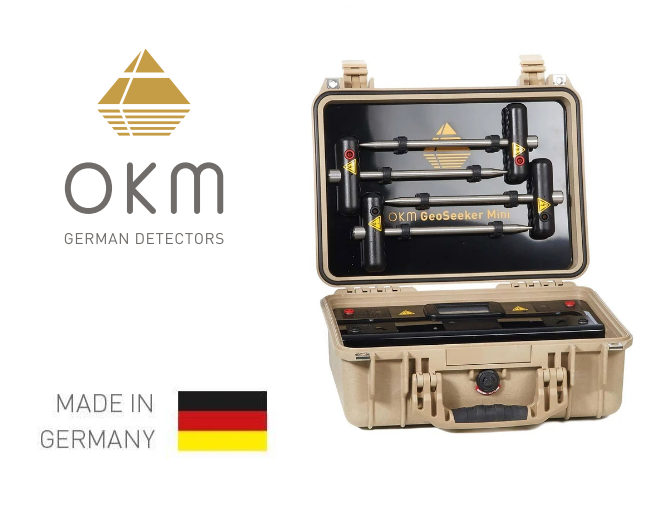

OKM Geoseeker Mini
Products / OKM Ground Metal Detectors
Quantity:
Specification:
Geoelectric water and cavity detector: Determines the ground resistance up to a depth of 100m and visualizes the measured values in 2D
Depth: Customers found water up to 100 meters
Use cases: water detection, cavity detection, geotechnical engineering
Operating modes: Geoelectrical scan
Detectable objects: water deposits, water-bearing gravel, cavities
Made in Germany
More-Details:
Water detector and cavity detector up to 100 meters (328 ft) depth
Like his big brother GeoSeeker, the GeoSeeker Mini utilizes a geoelectrical measurement procedure based on Schlumberger. The water detector – that can also be used to detect underground cavities – determines the soil resistivity. Based on that apparent resistivity of the ground the detector is able to detect underground water resources like fresh water, drinking water, water-bearing gravel and groundwater level.
Based on the fact that underground water has a very good conductivity, you can conclude that very bad conductivity is a hint for hidden cavities like caves, tunnels, chambers and underground rooms. Thus, the geophysical detector GeoSeeker Mini can be deployed as water finder and cavity detector at the same time.
Operating the water and cavity detector GeoSeeker Mini
The water detector GeoSeeker Mini is operated via touchscreen. Select the measurement depth as well as the amount of scanning points and simply follow the graphical instructions. Due to easy-to-understand images and icons, the GeoSeeker Mini is multilingual by using pure picture language.
4 mini.png
During the measurement the electrodes have to be replaced several times to measure the ground resistivity at certain places. All instructions can be read from the color display, where the results are presented after each single scan. At the very end of a measurement the final result is shown as a graphical 2D scan image.
Data visualization of water resources and cavity
After finishing a geoelectrical measurement, the final result is calculated to generate a representative 2D scan image of the underground resistivity. With the pictograms in the lower display area, users can read directly the diagram: The colors in the scheme indicate water deposits (blue with water drops) and/or detected cavities (red with tunnel symbol).
5 mini.png
Depending on the selection of the size and depth of the measurement, the display contains several columns and is provided with corresponding depth information.
Using the left button (water drops) and the middle button (tunnel entrance), the user can switch to simplified representations of the measurement results.
6 mini.png
7 mini.png
Thanks to the realization of step-by-step instructions and results in simple images and pictograms, the GeoSeeker Mini is language-independent. That means, the water detector can be used by inexperienced users all over the world – no matter what language they speak.1 mini.png
Geoelectrical applications with GeoSeeker Mini
The geoelectrical detector OKM GeoSeeker Mini can be used to detect underground water resources as well as hidden cavities. Both structures can be located due to its specific characteristics of electrical resistivity.
Water detection
Underground water resources have a good electrical conductivity and measuring its resistivity will result in low apparent resistivity values. The capability of water detection is very useful for
dowsers, water finders
well builders, drilling companies
agriculture, fruit growing
mining, building contractors
Detectable subsurface water deposits could be
ground water level
fresh water, drinking water
underground watercourse, water veins
underground water streams, headwaters
Cavity detection
Hidden cavities and hollow spaces have a rather poor electrical conductivity and measuring its resistivity will result in high apparent resistivity values. The capability of cavity detection is useful for
archaeologists, historians
treasure hunters
geotechnical engineering
military services
building contractors
Detectable subsurface cavities could be
caves, tunnels
galleries and manholes
chambers, sepulchers, tombs
bunkers, vaults, cellars, rooms
